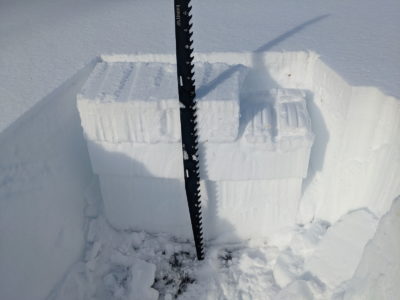Basic Information
Observation Details
Observation Date:
December 24, 2022Submitted:
December 25, 2022Observer:
SAC - VandenBosZone or Region:
Galena Summit and Eastern MtnsLocation:
Owl/Coyote divide (7,100-8,500', N-NE-E-SE-S)Signs of Unstable Snow
Recent Avalanches?
None ObservedCracking?
None ExperiencedCollapsing?
IsolatedSnow Stability
Stability Rating:
FairConfidence in Rating:
ModerateStability Trend:
SteadyBottom Line
I found reactive weak layers in the middle and upper snowpack today on slopes that face the sun. These produced unstable snowpack test results and audible collapses where stiffer wind drifts sat on top of them. Warm temperatures were working to melt the upper portion of the snowpack and change its properties.
Advanced Information
Weather Summary
Cloud Cover:
Partly CloudyVariable cloud cover with high clouds streaming through from time to time. Cloud cover increasing towards sunset with a bank of lower clouds pouring over the crest of the Smokys. Calm to light winds and warm temperatures
Avalanche Observations
| # | Date | Location | Size | Type | Bed Sfc | Depth | Trigger | Photos | Details |
|---|---|---|---|---|---|---|---|---|---|
| 2 |
Dec 21, 2022 (+/- 1 day) |
Cherry Creek SW 10100ft |
D2 | HS-Hard Slab | N-Natural | Report | |||
| 1 |
Dec 21, 2022 (+/- 1 day) |
Galena Peak SW 10400ft |
D2.5 | HS-Hard Slab | N-Natural |

|
Report |
I observed the aftermath of several large to very large slides in the Boulder Mountains. These appear to have happened during the solstice wind event. I also observed a number of suspicious debris piles without crowns, the timing on these is uncertain. Observations of more avalanches on solar slopes in the past week continue to point to issues involving crusts and facets. Its somewhat easy to ignore these since they happened during the big wind event and they are less obvious, but I think that would be a mistake. It is safe to say we have persistent slab issues here as well.
Snowpack Observations
My primary goal today was to continue the search for weak layers in the mid and upper snowpack (12/8 and 12/19) and to get a feel for how much the warm temperatures were affecting the upper snowpack.
In a middle elevation snowpit ( SSE@8,500', HS=75-80cm) I found both 12/8 and 12/19 to be present and reactive. They both presented as small facets accompanied by subtle crusts. 12/19 is buried 15cm down and 12/8 is down 30-35cm. 12/8 produced ECTP 4, 2, 4, 5, and 12/19 produced ECTP16, 12, 13, and 15. The slope I dug on had seen some wind loading during the solstice wind-event, but the overlying slab was not terribly stiff (4F), and some of the "meat" to the slab likely came from warming air temperatures today. 11/27 did exist in this location but was somewhat irregular. My pit location was meant to target 12/8 and 12/19, 11/27 was not well preserved here (relatively steep, rocky terrain). It presented as an icy MFcr that was adhered to the ground with some moist, large FC on top. I also dug a bit lower on an E facing slope and found both 12/8 and 12/19, but they were less reactive without the crust (mix of ECTNs and ECTPs with moderate force.
Warm temperatures were having a noticeable effect on the snowpack. On shaded slopes the snow remained dry, on solar aspects the snow was becoming moist in the upper 10cm of the snowpack. I observed seas of rollerballs in sheltered, steep terrain by 1300.

Avalanche Problems
Persistent weak layers continue to top the problem list, described in more detail above. 11/27, 12/8, and 12/19.
